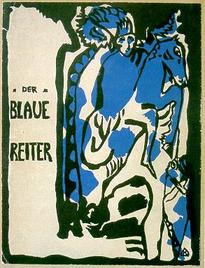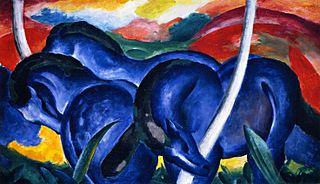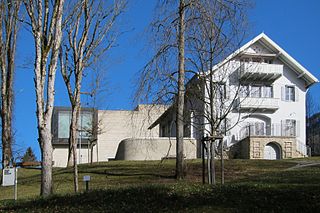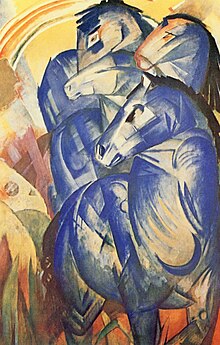
Paul Klee was a Swiss-born German artist. His highly individual style was influenced by movements in art that included expressionism, cubism, and surrealism. Klee was a natural draftsman who experimented with and eventually deeply explored color theory, writing about it extensively; his lectures Writings on Form and Design Theory, published in English as the Paul Klee Notebooks, are held to be as important for modern art as Leonardo da Vinci's A Treatise on Painting was for the Renaissance. He and his colleague, Russian painter Wassily Kandinsky, both taught at the Bauhaus school of art, design and architecture in Germany. His works reflect his dry humor and his sometimes childlike perspective, his personal moods and beliefs, and his musicality.

Franz Moritz Wilhelm Marc was a German painter and printmaker, one of the key figures of German Expressionism. He was a founding member of Der Blaue Reiter, a journal whose name later became synonymous with the circle of artists collaborating in it.

Degenerate art was a term adopted in the 1920s by the Nazi Party in Germany to describe modern art. During the dictatorship of Adolf Hitler, German modernist art, including many works of internationally renowned artists, was removed from state-owned museums and banned in Nazi Germany on the grounds that such art was an "insult to German feeling", un-German, Freemasonic, Jewish, or Communist in nature. Those identified as degenerate artists were subjected to sanctions that included being dismissed from teaching positions, being forbidden to exhibit or to sell their art, and in some cases being forbidden to produce art.

Events from the year 1911 in art.

Der Blaue Reiter was a group of artists and a designation by Wassily Kandinsky and Franz Marc for their exhibition and publication activities, in which both artists acted as sole editors in the almanac of the same name. The editorial team organized two exhibitions in Munich in 1911 and 1912 to demonstrate their art-theoretical ideas based on the works of art exhibited. Traveling exhibitions in German and other European cities followed. The Blue Rider disbanded at the start of World War I in 1914.

August Robert Ludwig Macke was a German Expressionist painter. He was one of the leading members of the German Expressionist group Der Blaue Reiter. He lived during a particularly active time for German art: he saw the development of the main German Expressionist movements as well as the arrival of the successive avant-garde movements which were forming in the rest of Europe. As an artist of his time, Macke knew how to integrate into his painting the elements of the avant-garde which most interested him. Like his friend Franz Marc and Otto Soltau, he was one of the young German artists who died in the First World War.

Blue Horses is a 1911 painting by German painter and printmaker Franz Marc (1880–1916).

Norbert Bisky is a German artist based in Berlin. He is one of the most important representatives of a new figurative painting in the 21st century.
Paul Boldt was one of the poets of German Expressionism.

Wilhelm Peter Bruno Lohse was a German art dealer and SS-Hauptsturmführer who, during World War II, became the chief art looter in Paris for Hermann Göring, helping the Nazi leader amass a vast collection of plundered artworks. During the war, Göring boasted that he owned the largest private art collection in Europe.

The Kronprinzenpalais is a former Royal Prussian residence on Unter den Linden boulevard in the historic centre of Berlin. It was built in 1663 and renovated in 1857 according to plans by Heinrich Strack in Neoclassical style. From 1919 to 1937, it was home to the modern art collection of the National Gallery. Damaged during the Allied bombing in World War II, the Kronprinzenpalais was rebuilt from 1968 to 1970 by Richard Paulick as part of the Forum Fridericianum. In 1990, the German Reunification Treaty was signed in the listed building. Since then, it has been used for events and exhibitions.

Wilhelm Morgner was a German Expressionist painter and graphic artist.

The Franz Marc Museum is a museum located in Kochel am See, Upper Bavaria, dedicated to German Expressionist painter Franz Marc. The museum shows paintings by Franz Marc, and also works of art of his contemporaries and other important artists of the 20th century, in a permanent and in temporary exhibitions.

Bernhard Koehler was a German industrialist and art collector.

Lempertz is a German auction house which emerged from a bookstore and art gallery founded 1845 in Bonn, Germany. It is entirely owned and controlled by the Lempertz family and headquartered in Cologne, Germany.

Fox, also known as Blue and Black Fox or Blue Fox, is an oil on canvas painting by Franz Marc, from 1911. It is part of the collection of the Von der Heydt Museum in Wuppertal.

Horses in Landscape is a watercolour with pencil on paper by the German painter Franz Marc, executed in 1911. It is probably a study, which was thought to be lost, for the painting Blue Horses (1911). The painting became known worldwide on the occasion of the Schwabing art discovery in November 2013. It was one of the first eleven works to be shown at a press conference by the Augsburg public prosecutor. The small-format work measures 12.1 × 19.6 cm.
Stefan Koldehoff is a German journalist, art market expert and non-fiction author. He became known through numerous publications and his work as culture editor of the Deutschlandfunk.

Alfred Gustav Christian Roloff was a German artist and illustrator; best known for his dime novel covers and paintings of horses.


















